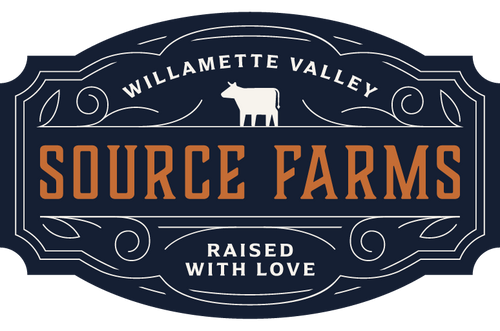Navigating through the maze of modern agriculture can be intimidating—we get it. As more people educate themselves about where their food is coming from and how it’s been produced, it’s important to understand what different agricultural labels really mean, both in terms of the food itself and of the land it was cultivated on. In beginning to understand what terms like “organic,” “sustainable,” and “regenerative,” really mean, we empower ourselves to make more informed choices around the food we eat and the sources we support. So, here’s a breakdown!
What is Organic Agriculture?
The USDA started the National Organic Program (NOP) in 2002 “to facilitate domestic and international marketing of fresh and processed food that is organically produced and assure consumers that such products meet consistent, uniform standards.” These standards prohibit the utilization of genetic engineering, require the use of organic seeds, and allow only animal waste or approved, biologically-derived products to be employed for soil and crop nutrition. Organic farming means the food was grown and processed without the use of synthetic fertilizers or pesticides. Pesticides derived from natural sources (such as biological pesticides) may be sometimes be used in producing organically grown food. USDA guidelines also encourage the use of cover crops (though tillage is still an approved organic practice. Tillage is the manipulation of the soil into a desired condition by mechanical means; tools are employed to achieve some desired effect, such as pulverization, cutting, or movement). All farmers who produce under the organic label are bound to these guidelines, and it’s a guarantee that all crops sold as “organic” meet USDA standards.
However, while organic guidelines do a lot to ensure the safety of crops, they don’t exactly address pressing issues such as soil health and carbon emissions. Some conventional farming practices, like mono-cropping and deep tillage, still result in a loss of topsoil and the loss of crucial microorganisms and nutrients, even though they are permitted farming methods under certified organic standards.
This means that large-scale commodity crop farmers can still sell under the organic label despite the fact that their goal isn’t necessarily soil health. Because different crops provide a different set of benefits for the land, soil needs to host a variety of different crops and plants to protect its structure and integrity. When the same crop is planted in the same plot of land over and over again—a practice known as monocropping—the soil only receives and extracts the same nutrients provided by that crop. Organic guidelines don’t require farmers to produce an array of crops, so many organic farms still partake in monocropping. Over time, this reduces soil fertility and crop yield, rendering the farmland less and less productive each year and releasing carbon essential to soil vitality into the atmosphere.
This doesn’t inherently mean that organic practices are useless, though—they still ensure that crops are being treated with naturally derived and harm-free products. It’s important to recognize, though, that organic agriculture is simply not enough. The future of agriculture depends upon innovation, and though organic practices are still incredibly important and valuable, it’s what we derive from them and how we adapt them to work alongside other sustainable and regenerative farming methods that will secure the fertility of farmland for years to come.
How does organic agriculture come into play at Source Farms? While we aren't certified organic, our farmers do use organic practices, while focusing heavily on sustainable and regenerative agriculture.
What is Sustainable Agriculture?
Sustainable agriculture is the original form of agriculture (the OG). Sustainable agriculture has evolved over decades from an effort to battle the use of pesticides, GMOs, and monocropping often found in the big agriculture industry. In 2015, the USDA created a sustainable agriculture program defined as an, “integrated system of plant and animal production practices,” with the goal of making the most efficient use of the nonrenewable resources found on any given farm and working alongside (not against) the environment and natural resources that the agriculture economy depends on.
Though sustainable agriculture has a much less defined standard than certified organic agriculture, its guiding principles can be found in a variety of different ways on practicing farms. Some sustainable farms choose to implement the use of cover crops—crops planted with the sole intention of covering and protecting soil as opposed to profit—allowing farmers to manage soil quality, erosion, and fertility without tillage, which results in reduced soil disturbance. Other farms employ rotational grazing, the practice of moving grazing animals like cows and goats from pasture to pasture to improve the health of both the soil and the animals. Unlike traditional continuous grazing (where animals graze the same pasture over and over again), rotational grazing encourages plants to grow deeper root systems after animals move onto new pastures, leading to vegetation regrowth, increased biodiversity, and soil stability. Crop rotation is another common sustainable farming approach, as each crop offers the soil specific nutrients vital to ensuring its longevity.
These methods, alongside many other practices intended to enhance soil conservation, work in tandem to maintain healthy soil for the next year’s harvest. The overarching goal of sustainable agriculture is to mimic nature and its innate rhythms, reducing human impact on centuries-old land. However, that’s not always enough. While sustainable farming has been a massive step in the agriculture industry’s effort to improve carbon sequestration and preserve soil integrity, it’s nearly impossible to keep every aspect of a farm’s delicate ecosystem in balance using only sustainable practices.
Even though sustainable farmers use the resources of their farmland to its fullest extent to protect soil health, they aren’t often improvingit. Without implementing agricultural strategies to actively improve the organic matter and nutrients in soil, that soil will still degrade and become less productive each year. Both organic and sustainable farms still result in a loss of topsoil, meaning that the soil is losing microorganisms, carbon, and fertility. Essentially, after enough time, the soil just becomes dirt—dirt that has to be supported by more and more artificial inputs each year to maintain its production.
At Source Farms, this is the minimum required agricultural standard we ensure our farm partners adhere to. Beef from Coleman Ranch and lamb from Cody Woods will always be at least sustainably raised.
Regenerative Agriculture as a Crossroads
So what is regenerative farming, anyways?
Though the USDA has not officially defined what regenerative agriculture entails, many view it as a continuation of sustainable agriculture, ever-evolving to fit each unique piece of farmland. Regenerative agriculture serves as a holistic approach to farmland care, intertwining the best aspects of both organic and sustainable farming. Its philosophy centers wholly around harmony with the land and a deeper appreciation of that land’s ability to manage itself.
Every farm is different, which means the practices that regenerative agriculture entails will vary from farm to farm. No matter what, though, all regenerative principles have the same goal—establishing a relationship between people and land that revolves around “stewardship” as opposed to “ownership.” These principles stem entirely from the constant innovation of farmers, scientists, and engineers who have learned to listen to the land instead of attempting to control it.
Ultimately, regenerative farming does everything that organic and sustainable farming cannot. Similar to organic farming standards, regenerative farms don’t typically use synthetic chemicals or fertilizers, relying solely on compost and animal waste to improve soil and crop health. Regenerative agriculture also utilizes many of the methods sustainable farms have been practicing for decades, such as rotational grazing and crop rotation. However, it’s the crossroads of organic and sustainable agriculture that has allowed regenerative farmers to step even further and create something entirely new.
At our own founding farm, Tabula Rasa Farms, our use of regenerative techniques means that our land will be fertile for generations, and that our use of it has only increased its overall health. These techniques come in countless different forms, from no-till/no-dig farming systems, using multiple species rotational grazing animals to improve carbon sequestration, to the cultivation of a variety of crops all intended to provide soil with essential nutrients.
Our regenerative principles, alongside all the work other regenerative initiatives all around the world are doing, are all an effort not only to ensure, but increase the vitality of topsoil. It’s a living, breathing relationship between us and the farmland that provides for us, and it’s our responsibility to do as much to protect it as possible.
In a world where so much uncertainty lies around your food and where it comes from, you can rest assured that our regenerative practices allow us the opportunity to feed our community while maintaining a careful stewardship of the land that food comes from. The future of agriculture lies not in isolation, but in the interconnectedness of organic, sustainable, and regenerative principles, each contributing to a more resilient and enduring food system—and we’re glad to be a part of it. It’s a beacon of hope for a more sustainable future, where the cultivation of the land and the nourishment it provides will always go hand in hand.
At Source Farms, any products that come from Tabula Rasa Farms will always be regeneratively raised or grown. Think of these products as the best-of-the-best!
Related links: Weekly Regenerative Produce Subscription: 2024 Vegetable CSA


